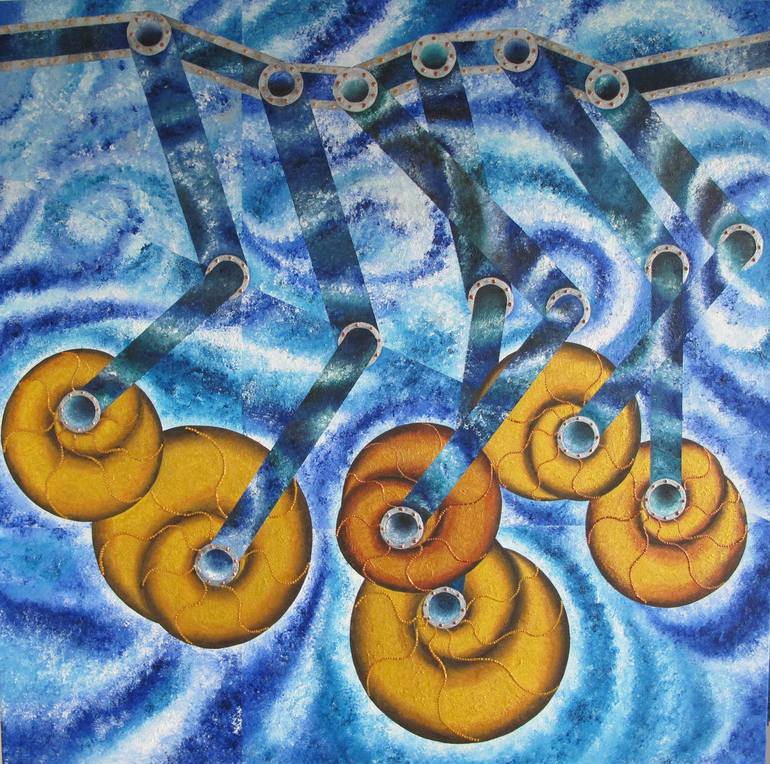


449 Views
1
View In My Room
The Montpellier Pantograph Painting
Robert Pigott
Painting, Acrylic on Canvas
Size: 48 W x 48 H x 2 D in
Ships in a Crate
$10,775
Shipping included
14-day satisfaction guarantee
Trustpilot Score
449 Views
1
Artist Recognition

Artist featured in a collection
ABOUT THE ARTWORK
DETAILS AND DIMENSIONS
SHIPPING AND RETURNS
The Montpellier Pantograph is now close to completion. A few remaining areas require some attention where paint bleeds into other colours. All of the raised points on the pantograph have been coloured to better distinguish them from the background. This also helps to convey the idea of a flow of par...
Year Created:
2012
Subject:
Styles:
Mediums:
Painting, Acrylic on Canvas
Rarity:
One-of-a-kind Artwork
Size:
48 W x 48 H x 2 D in
Ready to Hang:
Not Applicable
Frame:
Not Framed
Authenticity:
Certificate is Included
Packaging:
Ships in a Crate
Delivery Cost:
Shipping is included in price.
Delivery Time:
Typically 5-7 business days for domestic shipments, 10-14 business days for international shipments.
Returns:
14-day return policy. Visit our help section for more information.
Handling:
Ships in a wooden crate for additional protection of heavy or oversized artworks. Artists are responsible for packaging and adhering to Saatchi Art’s packaging guidelines.
Ships From:
United Kingdom.
Customs:
Shipments from United Kingdom may experience delays due to country's regulations for exporting valuable artworks.
Need more information?
Need more information?
Robert Pigott was born in the UK in 1948, in Brigg, Lincolnshire and educated at Brigg Grammar. Following the Art Foundation course at Leicester College of Art he moved to Stockport in Greater Manchester to study Art and Design for Advertising. In 1971 he won a scholarship with the advertising agency, J.Walter Thompson in London, and remained there as Art Director for several years. During this time, he studied painting with the artist Rudolf Ray in London and in Mexico. Ray, whose work had been praised by fellow Austrian, Oskar Kokoschka, was an important influence. (Ray had previously worked with Marcel Duchamp in Paris and was to accompany him to New York in 1942, where Duchamp introduced Ray to Peggy Guggenheim). Despite the early encouragement from Ray it was only very much later that the process of art was taken more seriously. He is currently dividing his time between painting and researching and writing a new book entitled, The Nazareth Parallel, a radical work which blurs the boundaries between Science and Religion. Many of his paintings are used in the book to illustrate his unique ideas and concepts. The painting Ananke is used on the cover design. For more information go to the artist's website at About The Art Painting is a search tool, a telescope, a probe, a scientific instrument directed inwards to view the soul of the individual, the soul of Man and the metaphysical world. The canvas, the painting is a direct expression of the probing, the image captured by the telescope's long exposure to the space within and the mystery of existence. My own need for certainty in the world became the catalyst for a new period of creativity. I considered that through the deliberate use of painting as a tool, its probing potential could be directed to answer the more funadamental questions about ourselves and our world, the notion that painting can be included as a way of enquiry about our world just as, in the same way, Science makes sense of the nature of things around us. In the time of the Renaissance Art and Science were not separated as they are today but were considered as one discipline. In 1954 Herbert Read considered the role of the artist was to retire within oneself, to reach down into the well of consciousness, in an attempt to reach sources of inspiration that do not belong to our time and civilisation, but are archetypal and universal.
Artist Recognition

Artist featured by Saatchi Art in a collection
Why Saatchi Art?
Thousands of
5-Star Reviews
We deliver world-class customer service to all of our art buyers.
Global Selection of Original Art
Explore an unparalleled artwork selection from around the world.
Satisfaction Guaranteed
Our 14-day satisfaction guarantee allows you to buy with confidence.
Support Emerging Artists
We pay our artists more on every sale than other galleries.
